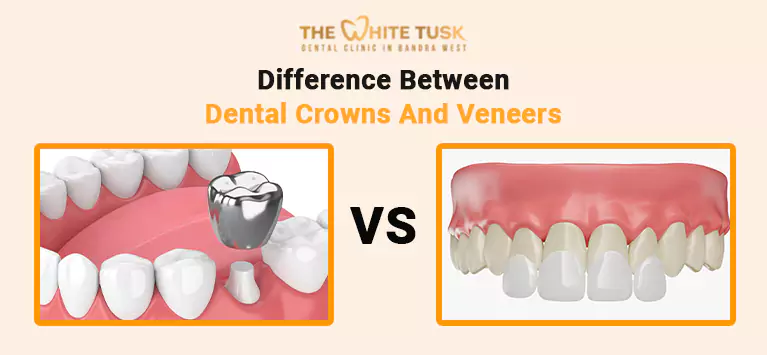
Navigating cosmetic dentistry choices like crowns and veneers can be complex yet rewarding. These options not only enhance your smile but also protect your oral health. Understanding their differences, applications, and benefits is crucial for an informed decision. This blog clarifies the variances between crowns and veneers, empowering you to choose wisely based on your dental health goals and cosmetic preferences. Whether addressing decay, tooth damage, or smile enhancement, grasping these procedures is key to a confident, healthier you.
Two popular dental procedures that cater to different needs but share a common goal: enhancing oral health and cosmetic appearance.
Dental crowns, often called “teeth caps,” are custom-made restorations covering the entire tooth. Crafted from materials like porcelain, ceramic, or metal alloys, crowns are designed to protect, cover, and restore the shape of your teeth when fillings don’t solve the problem. They play a pivotal role in cosmetic dentistry by improving teeth’ appearance and strengthening damaged ones, making them indispensable for oral health maintenance.
On the other hand, dental veneers are thin, custom-made shells crafted from porcelain or composite resin designed to cover the front side of the teeth. Think of them as a covering that enhances the appearance of your teeth by altering their colour, shape, size, or length. Veneers are a go-to solution for individuals looking to rectify minor imperfections like discolouration, chips, or gaps without extensive crown coverage.
Despite their similarities in enhancing the cosmetic appeal of teeth, dental crowns and veneers serve distinct purposes based on the patient’s oral health needs and desired outcomes.
The primary function of dental crowns is to encase the entire tooth, providing a robust layer of protection against further damage while restoring its natural function. They’re especially beneficial for teeth with significant decay and fractures or root canal treatments. Crowns for teeth enhance the tooth’s appearance and secure its structural integrity, making them ideal for patients requiring both restorative and cosmetic solutions.
Dental veneers, conversely, are primarily used for cosmetic purposes. Their thin design is perfect for transforming the dental aesthetic without invasive procedures. It offers an ideal solution for individuals looking to correct minor flaws like slight misalignments, chips, or stubborn stains that teeth whitening can’t address. Veneers preserve more natural tooth structure than crowns, making them a less invasive option for those seeking cosmetic improvements alone.
Understanding the procedures for dental crowns and veneers is crucial when deciding on cosmetic dentistry options. Both aim at improving your smile but differ significantly in process and application.
The procedure for dental crowns involves thorough preparation. Typically known as “teeth caps,” crowns cover the entire tooth. The process begins with removing part of the tooth enamel to create space for the crown. A dental impression is then taken to craft a custom crown, matching the tooth’s original appearance. This step ensures that the crown fits perfectly over the tooth, restoring its shape, size, and strength. Temporary crowns may be placed while waiting for the permanent one. Once ready, the permanent crown is cemented, completing the restoration.
Conversely, dental veneers require less tooth structure removal. These thin porcelain or composite resin layers are designed to cover the front surface of teeth, enhancing their appearance. The procedure begins with slightly reshaping the tooth’s surface and an impression to customise the veneer. Unlike crowns, veneers focus on cosmetic improvement rather than structural restoration. After preparing the tooth, the veneer is bonded to the front of the tooth, instantly improving its appearance.
When pondering the choice between dental crowns and dental veneers as options for cosmetic dentistry, their longevity and durability are significant factors to consider. Dental crowns offer a robust solution lasting 10 to 15 years or more with proper oral health care. Made from various materials such as porcelain, ceramic, metal, or a combination, they are designed to withstand the forces of chewing, providing a durable option for restoring teeth.
On the other hand, dental veneers, which are thin shells bonded to the front of the teeth, typically last about 7 to 15 years. Veneers are primarily made from porcelain, balancing strength and a natural appearance. While they are resistant to stains and can withstand daily wear and tear, veneers are not as strong as dental crowns and may not be the best option for teeth that require significant structural repair.
Regular oral hygiene practices like brushing twice a day and flossing daily are paramount for dental crowns. It’s also advisable to avoid hard foods and items that can crack or damage the crown. Periodic dental check-ups are critical to assess the tooth’s health under the crown and the crown itself.
Dental veneers require a slightly different approach. While brushing and flossing are still essential, individuals with veneers should use non-abrasive toothpaste to avoid scratching the surface. Avoiding foods and beverages that can stain, like coffee, tea, and red wine, is also recommended to maintain the veneer’s aesthetic. Like crowns, regular dental visits ensure veneers stay in pristine condition.
Choosing between dental crowns and veneers depends on several factors unique to each individual’s dental health and cosmetic goals. Here are some considerations to help you make an informed decision:
Both dental crowns and veneers serve as robust and lasting solutions within cosmetic dentistry, yet each addresses different needs and dental conditions. Consulting a dental professional is vital to determine the best option for individual needs. The decision between crowns and veneers impacts oral health, confidence, and smile appearance. Crowns offer comprehensive coverage, while veneers provide subtle enhancements for a radiant smile. Choose wisely based on personal health goals and aesthetic preferences.
My partner and I absolutely love your blog and find many
of your post’s to be precisely what I’m looking for. can you offer guest writers to write content to
suit your needs? I wouldn’t mind producing a post
or elaborating on some of the subjects you write regarding
here. Again, awesome web log! https://menbehealth.wordpress.com/